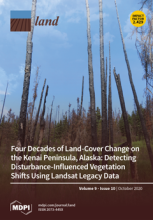/ library resources
Showing items 46 through 54 of 1952.Although the way in which vegetation phenology mediates the feedback of vegetation to climate systems is now well understood, the magnitude of these changes is still unknown.
Preserving landscape connectivity is one of the most frequently recommended strategies to address the synergistic threats of climate change, habitat fragmentation, and intensifying disturbances.
This paper estimates global logistic regression and logistic geographically weighted regression (GWR) models of urban growth in the adjacent border cities of Laredo, Texas in the United States and Nuevo Laredo, Tamaulipas in Mexico, for two time periods from 1985 to 2014.
Amid climate change, biodiversity loss and food insecurity, there is the growing need to draw synergies between micro-scale environmental processes and practices, and macro-level ecosystem dynamics to facilitate conservation decision-making.
The aim of the paper was to present the procedure of building neighborhood resilience to climate threats, embedded in planning (from the strategic to local level) and design process and focused on usage of natural adaptive potential.
This article presents a methodology for evaluating the potential for an urban area to become a 15-min city based on its existing essential urban functions.
Roughly 90% of farmers in the Western Cape Province of South Africa have converted to no-tillage systems to improve the efficiency of crop production. Implementation of no-tillage restricts the mixing of soil amendments, such as limestone, into soil.
Piping erosion is one form of water erosion that leads to significant changes in the landscape and environmental degradation.
Sustainable forest management activities, such as future crop tree (FCT) release treatments, became part of the REDD+ strategy to avoid carbon emissions from forests. FCT release treatments are intended to achieve increased growth of FCTs by removing competitor trees.
Pagination
Land Library Search
Through our robust search engine, you can search for any item of the over 73,000 highly curated resources in the Land Library.
If you would like to find an overview of what is possible, feel free to peruse the Search Guide.

